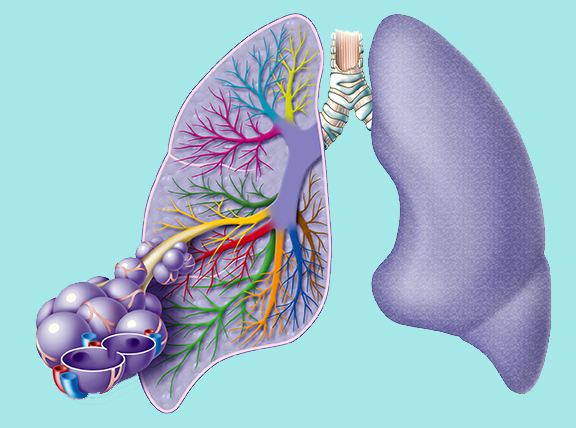Effect of Neonatal Hyperoxia on Lung Development
 The preterm infant lung is exposed too soon to oxygen and often to excess oxygen used clinically to treat respiratory distress. This can contribute to bronchopulmonary dysplasia (BPD), a chronic form of lung disease characterized by decreased angiogenesis, alveolar simplification and restrictive airways. Infant mortality has been reduced by the therapeutic use of surfactant, antenatal steroids, and milder ventilation strategies. However, survivors of preterm birth continue to show persistent pulmonary disease (PPD) later in life.
The preterm infant lung is exposed too soon to oxygen and often to excess oxygen used clinically to treat respiratory distress. This can contribute to bronchopulmonary dysplasia (BPD), a chronic form of lung disease characterized by decreased angiogenesis, alveolar simplification and restrictive airways. Infant mortality has been reduced by the therapeutic use of surfactant, antenatal steroids, and milder ventilation strategies. However, survivors of preterm birth continue to show persistent pulmonary disease (PPD) later in life.
We developed a novel mouse model designed to understand how hyperoxia at birth permanently alters lung development. We discovered that adult mice exposed to hyperoxia between postnatal days 0-4 have mild airway hyperresponsiveness and alveolar simplification when compared to siblings exposed to room air. Although reduced angiogenesis is not seen at this age, alveolar simplification was attributed in part to altered development of alveolar epithelial type 2 (AEC2) and type 1 (AEC1) cells. AEC2s produce pulmonary surfactant lipids and proteins that maintain alveolar homeostasis and immunity against respiratory pathogens. AEC2s also serve as progenitors for AEC1s, which exchange oxidant gases between the lung and blood.
While fate mapping how AEC2s were lost, we made the surprising discovery that neonatal hyperoxia increases the number of AEC2s by stimulating their self-renewal and differentiation of airway Scgb1a1+ progenitors. However, these cells are then depleted during recovery in room air when they transdifferentiate into AEC1s.
Genetic lineage mapping combined with transcriptional and metabolic profiling of purified populations of AEC1s and AEC2s is currently being used to understand how neonatal hyperoxia alters proliferation of AEC2s and their differentiation into AEC1s.